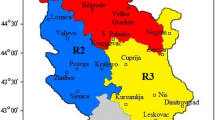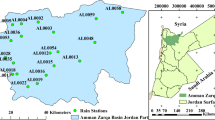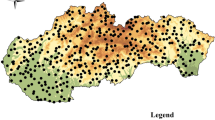Abstract
Precipitation is one of the key components in the water cycle. To analyse the changes in precipitation at a specific location, it is necessary to identify the distribution that best fits the precipitation data. For this purpose, three distributions i.e. generalized extreme value (GEV), generalized Pareto (GPD), and generalized logistic (GLO) were fitted to the annual precipitation data collected from 28 meteorological stations in Serbia for the period 1946–2019 using the method of L-moment. The goodness-of-fit for the selected three distributions was confirmed using the L-diagram and three measures namely relative root mean square error, relative mean absolute error, and probability plot correlation coefficient. From the results of this analysis, the GEV distribution was selected as the best fitting distribution of the annual precipitation data in Serbia. The increasing trends are presented in the western part of Serbia that can cause higher risks of floods than in other parts.








Similar content being viewed by others
References
Coles S (2001) An introduction to statistical modelling of extremevalues, Springer series in statistics. Springer-Verlag, London
De Michele C (2019) Advances in deriving the exact distribution of maximum annual daily precipitation. Water (Switzerland) 11(11):2322
Filliben JJ (1975) The probability plot correlation coefficient test for normality. Technometrics 17(1):111–117
Gellens D (2002) Combining regional approach and data extension procedure for assessing GEV distribution of extreme precipitation in Belgium. J Hydrol 268:113–126
Gocic M, Trajkovic S (2014a) Spatiotemporal characteristics of drought in Serbia. J Hydrol 510:110–123
Gocic M, Trajkovic S (2014b) Spatio-temporal patterns of precipitation in Serbia. Theor Appl Climatol 117(3–4):419–431
Gocic M, Shamshirband S, Razak Z, Petkovic D, Ch S, Trajkovic S (2016) Long-term precipitation analysis and estimation of precipitation concentration index using three support vector machine methods. Adv Meteorol 7912357. https://doi.org/10.1155/2016/7912357
Greenwood JA, Landwehr JM, Matalas NC, Wallis JR (1979) Probability weighted moments: definition and relation to parameters of several distributions expressible in inverse form. Water Resour Res 15(5):1049–1054
Gringorten II (1963) A plotting rule for extreme probability paper. J Geophys Res 68:813–814
Hirose H (1995) Maximum likelihood parameter estimation in the three-parameter gamma distribution. Comput Stat Data Anal 20(4):343–354
Hosking JRM (1989) Some Theoretical Results Concerning L-moments. IBM T.J. Watson Research Center, New York
Hosking JRM (1990) L-moments: analysis and estimation of distributions using linear combinations of order statistics. J R Stat Soc Ser B 52(1):105–124
Hosking JRM, Wallis JR (1997) Regional frequency analysis. An approach based on L-moments. Cambridge University Press, Cambridge
Hu C, Xia J, She D, Xu C, Zhang L, Song Z, Zhao L (2019) A modified regional L-moment method for regional extreme precipitation frequency analysis in the Songliao River basin of China. Atmos Res 230:104629
Ibrahim MN (2019) Generalized distributions for modeling precipitation extremes based on the L moment approach for the Amman Zara Basin, Jordan. Theor Appl Climatol 138(1–2):1075–1093
Jeon JJ, Kim YO, Kim Y (2011) Expected probability weighted moment estimator for censored flood data. Adv Water Resour 34(8):933–945
Kjellström E (2004) Recent and future signatures of climate change in Europe. Ambio 23:193–198
Koutsoyiannis D (2004) Statistics of extremes and estimation of extreme rainfall 1. Theoretical investigation. Hydrol Sci J 49(4):575–590
Kysely J, Picek J (2007) Regional growth curves and improved design value estimates of extreme precipitation events in the Czech Republic. Clim Res 33:243–255
Landwehr JM (1979) Probability weighted moments compared with some traditional techniques in estimating Gumbel parameters and quantitles. Water Resour Res 15(5):1055–1064
Lazoglou G, Anagnostopoulou C, Skoulikaris C, Tolika K (2019) Bias correction of climate Model’s precipitation using the copula method and its application in River Basin simulation. Water 11:600
Li W, Duan Q, Ye A, Miao C (2019) An improved meta-Gaussian distribution model for post-processing of precipitation forecasts by censored maximum likelihood estimation. J Hydrol 574:801–810
Monish NT, Rehana S (2020) Suitability of distributions for standard precipitation and evapotranspiration index over meteorologically homogeneous zones of India. J Earth Syst Sci 129(1):25
Park JS, Jung HS (2002) Modelling Korean extreme rainfall using a kappa distribution and maximum likelihood estimate. Theor Appl Climatol 72:55–64
Park JS, Jung HS, Kim RS, Oh JH (2001) Modelling summer extreme rainfall over the Korean peninsula using Wakeby distribution. Int J Climatol 21:1371–1384
Philandras CM, Nastos PT, Kapsomenakis J, Douvis KC, Tselioudis G, Zerefos CS (2011) Long term precipitation trends and variability within the Mediterranean region. Nat Hazards Earth Syst Sci 11:3235–3250
Räisänen J, Hansson U, Ullerstig A, Döscher R, Graham LP, Jones C, Meier M, Samuelsson P, Willén U (2004) European climate in the late 21st century: regional simulations with two driving global models and two forcing scenarios. Clim Dyn 22:13–31
Tfwala CM, Rensburg LD, Schall R, Mosia SM, Dlamini P (2017) Precipitation intensity-duration-frequency curves and their uncertainties for Ghaap plateau. Clim Risk Manag 16:1–9
Tzavelas G (2009) Maximum likelihood parameter estimation in the three-parameter gamma distribution with the use of Mathematica. J Stat Comput Simul 79(12):1457–1466
Wei T, Song S (2019) Confidence interval estimation for precipitation quantiles based on principle of maximum entropy. Entropy 21(3):315
Wu Z, Shen Y, Wang H, Wu M (2020) An ontology-based framework for heterogeneous data management and its application for urban flood disasters. Earth Sci Inf 13:377–390. https://doi.org/10.1007/s12145-019-00439-3
Yuan J, Emura K, Farnham C, Alam MA (2018) Frequency analysis of annual maximum hourly precipitation and determination of best fit probability distribution for regions in Japan. Urban Clim 24:276–286
Yurekli K, Modarres R, Ozturk F (2009) Regional daily maximum rainfall estimation for Cekerek watershed by L-moments. Meteorol Appl 16:435–444
Zhang C, Zhou X, Lei W (2019) Necessary length of daily precipitation time series for different entropy measures. Earth Sci Inf 12:475–487. https://doi.org/10.1007/s12145-019-00392-1
Zin WZW, Jemain AA, Ibrahim K (2009) The best fitting distribution of annual maximum rainfall in peninsular Malaysia based on methods of L-moment and LQ-moment. Theor Appl Climatol 96:337–344
Acknowledgements
The presented research is a part of the project of Serbian Academy of Sciences and Arts Branch in Nis (O-15-18), Erasmus+ Jean Monnet Module “EU water policy and innovative solutions in water resources management” (Ref. no. 620003-EPP-1-2020-1-RS-EPPJMO-MODULE) and also funded by the Ministry of Education, Science and Technological Development of the Republic of Serbia.
Availability of data and material
The data are available from the corresponding author upon request.
Funding
Ministry of Education, Science and Technological Development of the Republic of Serbia.
Author information
Authors and Affiliations
Contributions
Milan Gocic designed the initial research, conducted research and wrote initial manuscript except Introduction chapter. Lazar Velimirovic plotted plotting the graphs. Miomir Stankovic checked the statistical analysis. Slavisa Trajkovic contributed in terms of improving the initial research, writing Introduction chapter, improving the written language of the manuscript and checking the overall logical flow of the manuscript. In addition, the authors pointed out necessary comments towards improving the quality of the final manuscript.
Corresponding author
Ethics declarations
Conflicts of interest
Authors declare that they have no conflict of interest.
Code availability
Not applicable.
Additional information
Publisher’s note
Springer Nature remains neutral with regard to jurisdictional claims in published maps and institutional affiliations.
Rights and permissions
About this article
Cite this article
Gocic, M., Velimirovic, L., Stankovic, M. et al. Determining the best fitting distribution of annual precipitation data in Serbia using L-moments method. Earth Sci Inform 14, 633–644 (2021). https://doi.org/10.1007/s12145-020-00543-9
Received:
Accepted:
Published:
Issue Date:
DOI: https://doi.org/10.1007/s12145-020-00543-9




